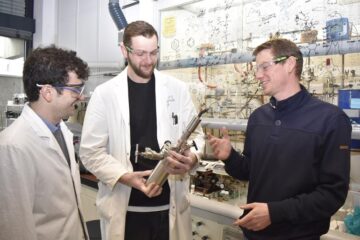Transit Search Finds Super-Neptune

While Neptune has a diameter 3.8 times that of Earth and a mass 17 times Earth's, the new world (named HAT-P-11b) is 4.7 times the size of Earth and has 25 Earth masses.
HAT-P-11b was discovered because it passes directly in front of (transits) its parent star, thereby blocking about 0.4 percent of the star's light. This periodic dimming was detected by a network of small, automated telescopes known as “HATNet,” which is operated by the Center in Arizona and Hawaii. HAT-P-11b is the 11th extrasolar planet found by HATNet, and the smallest yet discovered by any of the several transit search projects underway around the world.
Transit detections are particularly useful because the amount of dimming tells the astronomers how big the planet must be. By combining transit data with measurements of the star's “wobble” (radial velocity) made by large telescopes like Keck, astronomers can determine the mass of the planet.
A number of Neptune-like planets have been found recently by radial velocity searches, but HAT-P-11b is only the second Neptune-like planet found to transit its star, thus permitting the precise determination of its mass and radius.
The newfound world orbits very close to its star, revolving once every 4.88 days. As a result, it is baked to a temperature of around 1100 degrees F. The star itself is about three-fourths the size of our Sun and somewhat cooler.
There are signs of a second planet in the HAT-P-11 system, but more radial velocity data are needed to confirm that and determine its properties.
Another team has located one other transiting super-Neptune, known as GJ436b, around a different star. It was discovered by a radial velocity search and later found to have transits.
“Having two such objects to compare helps astronomers to test theories of planetary structure and formation,” said Harvard astronomer Gaspar Bakos, who led the discovery team.
HAT-P-11 is in the constellation Cygnus, which puts in it the field of view of NASA's upcoming Kepler spacecraft. Kepler will search for extrasolar planets using the same transit technique pioneered by ground-based telescopes. This mission potentially could detect the first Earth-like world orbiting a distant star. “In addition, however, we expect Kepler to measure the detailed properties of HAT-P-11 with the extraordinary precision possible only from space,” said Robert Noyes, another member of the discovery team.
Headquartered in Cambridge, Mass., the Harvard-Smithsonian Center for Astrophysics (CfA) is a joint collaboration between the Smithsonian Astrophysical Observatory and the Harvard College Observatory. CfA scientists, organized into six research divisions, study the origin, evolution and ultimate fate of the universe.
For more information, contact:
David A. Aguilar
Director of Public Affairs
Harvard-Smithsonian Center for Astrophysics
617-495-7462
daguilar@cfa.harvard.edu
Christine Pulliam
Public Affairs Specialist
Harvard-Smithsonian Center for Astrophysics
617-495-7463
cpulliam@cfa.harvard.edu
Media Contact
More Information:
http://www.cfa.harvard.eduAll latest news from the category: Physics and Astronomy
This area deals with the fundamental laws and building blocks of nature and how they interact, the properties and the behavior of matter, and research into space and time and their structures.
innovations-report provides in-depth reports and articles on subjects such as astrophysics, laser technologies, nuclear, quantum, particle and solid-state physics, nanotechnologies, planetary research and findings (Mars, Venus) and developments related to the Hubble Telescope.
Newest articles

Lower dose of mpox vaccine is safe
… and generates six-week antibody response equivalent to standard regimen. Study highlights need for defined markers of mpox immunity to inform public health use. A dose-sparing intradermal mpox vaccination regimen…

Efficient, sustainable and cost-effective hybrid energy storage system for modern power grids
EU project HyFlow: Over three years of research, the consortium of the EU project HyFlow has successfully developed a highly efficient, sustainable, and cost-effective hybrid energy storage system (HESS) that…

Safer alternative for an explosive reaction
The chemical industry has been using a reaction with explosive chemicals for over 100 years – now Mülheim scientists have discovered a safer alternative. The Ritter Group of the Max…





















